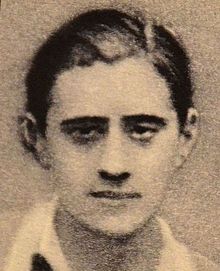Lejb Rotblat
Lejb (Lutek) Rotblat | |
|---|---|
 | |
| Born | 14 October 1918 Warsaw |
| Died | 8 May 1943 Warsaw |
| Known for | member of the Jewish Combat Organization (ŻOB), fighter in the Warsaw Ghetto Uprising |
Lejb (Lutek) Rotblat (born October 14, 1918 in Warsaw – May 8, 1943 in Warsaw) – activist of the Jewish resistance movement in the Warsaw Ghetto, member of Jewish Combat Organisation (ŻOB), participant in the Warsaw Ghetto Uprising.
He came from an assimilated Jewish family. He lost his father when he was little. After graduation from high school in 1937 he became a counsellor at HaNoar HaTzioni youth organisation. During the war he joined the Zionist Bnei Akiva youth movement. He lived together with his mother Maria (Miriam) Rotblat at 44 Muranowska Street in Warsaw. In March 1943 Arie Wilner found refuge in their flat. When deportation to Treblinka extermination camp took place in the summer of 1942 he and his mother, director of an orphanage at 18 Mylna Street, hid a group of Jewish children in one of the houses in the ghetto.[1]
On February 22, 1943 he participated in elimination of a Gestapo agent, Alfred Nossig.
Between January and April 1943 he took part in actions of collecting weapons for ŻOB. He was also engaged in production of weapons in the ghetto (hand grenades, bottles with petrol).[2] On the eve of the Warsaw Ghetto Uprising, in April 1943 he was appointed a commander of his group formed of Bnei Akiva members. The group fought in the so-called central ghetto area.
On May 8, 1943 he was with his mother in the bunker at 18 Mila Street. When the bunker was discovered by the Germans the fighters didn’t want to surrender. At command of Arie Wilner the majority of fighters committed suicide. Lutek shot his mother first, at her own request, and later took his own life.
He is buried in a mass grave along with other deceased ŻOB fighters in the spot where they perished, because no exhumation was ever conducted at 18 Mila Street.
Memorial
The name of Lutek Rotblat is engraved on the obelisk, set at the steps of the memorial known as Anielewicz Mound in 2006. It is among 51 names of fighters whose identities were established by historians.
References
Sources
- Grupińska, Anka (2003). Odczytanie Listy. Kraków: Wydawnictwo Literackie. p. 114. ISBN 83-08-03314-8.
- Lubetkin, Cywia (1999). Zagłada i powstanie. Warszawa: Wydawnictwo "Książka i Wiedza". p. 193. ISBN 83-05-13041-X.
